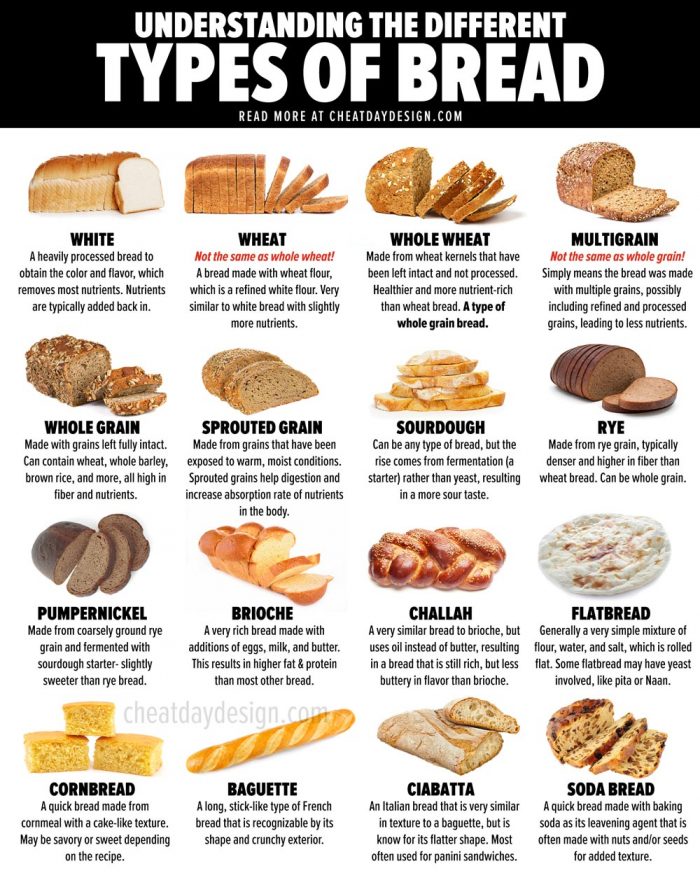
The word bread has become a catch-all term for any number of baked goods. But as with any other food, there are many different types of bread and each one has its own unique flavour, texture and even appearance. Here’s a brief guide to help you navigate the world of bread:
White Bread
White bread is made from white flour and can be enriched with vitamins and minerals. This type of bread is often used to make sandwiches and toast, but it’s also good for any number of recipes that call for a light colored loaf. It’s important to note that not all white breads are created equal–there are many different varieties of this style of loaf, each with its own unique texture, taste, and appearance (for instance: French baguettes vs Italian ciabatta).
Wheat Bread
Wheat bread is the most common type of bread. It’s made from wheat flour, which is a cereal grain that contains gluten. Wheat flour can be ground into many different types of flour, including whole wheat or white flours. White flour has had the germ removed and therefore has fewer nutrients than whole grain flour does; however, it produces better results when baking because it’s more light and fluffy than whole grain flours are. Wheat breads made entirely with these two types of flour will have different textures depending on how much each one was used in making them: if you want your loaf to be light and airy (like regular sandwich bread), then using primarily white flour would be best; however if you want something denser (like sourdough), then using mostly whole wheat will give you better results!
Whole Wheat Bread
Whole wheat bread is bread made with 100% whole wheat flour, which means it contains all of the grain’s endosperm and bran. Whole wheat bread has a more dense texture than white bread because it contains more fiber and nutrients than its lighter counterpart. A slice of whole wheat bread can have as much as five grams more fiber than its white counterpart, making it an ideal choice for those who want to add more fiber to their diets without sacrificing taste or texture. Whole-grain flours also have a stronger flavor than refined flours–many bakers describe this flavor as nutty or earthy–so if you’re not used to eating foods made from whole grains (or if you’re just not into strong flavors), then this might not be the best option for you!
Multigrain Bread
Multigrain bread is made with a blend of grains, which can vary depending on the country. In Europe, wheat, rye and barley are the most common grains used in multigrain breads. However, other grains such as oats, corn or millet may also be added to the mix. In North America and Australia it’s common for these types of breads to include two or three different types of flour–wheat flour (or whole wheat flour), rye flour and sometimes spelt flour–along with rolled oats as well as seeds like sunflower seeds or pumpkin seeds to add texture and flavor.
Whole Grain Bread
Whole grain bread is made with whole grains, such as wheat, rye, or oats. It’s high in fibre and vitamins and provides a good source of energy. Whole grain bread is also high in protein and low in fat.
Sourdough Bread
You may have heard of sourdough bread, but what exactly is it? Sourdough is a type of bread that’s fermented with wild yeast instead of commercial yeast. It’s made by letting flour and water sit for an extended period, which allows time for the natural yeasts in the air to ferment the mixture into dough. This process gives sourdough its distinctive tangy flavor–and also makes it healthier than regular white or wheat-based loaves! Sourdough has less gluten than other types of breads because it doesn’t rely on kneading to develop gluten strands (which can cause bloating). Fermented foods like kimchi have been shown to have probiotic effects on our digestive system by promoting healthy gut flora with beneficial bacteria such as Lactobacillus acidophilus.* Studies show that consuming sourdough boosts levels of B vitamins in your body.* And because there aren’t any added preservatives or additives involved in making this kind of loaf there isn’t any risk associated with eating something unhealthy like we talked about earlier…
Rye Bread
Rye bread is made from rye flour, which is a type of wheat. Rye grain is grown in Europe and Asia and used to make rye flour. Rye bread is not sourdough bread because it does not have any sourdough starter added to the dough while baking. Sourdough starters are living organisms that are used to ferment doughs and produce carbon dioxide bubbles during rising; they’re also responsible for giving sourdough its distinctive tangy flavor!
Pumpernickel Bread
Pumpernickel bread is a dark, dense bread made from rye flour. It has a slightly sweet flavor and can be used in sandwiches or as an accompaniment to soups and salads. The word “pumpernickel” comes from the German words “Pumpern,” meaning to smite or beat; and “Nickel,” which means devil or evil spirit. It’s thought that this name came about because the dough was kneaded so vigorously that it became hard to breathe while working with it! Pumpernickel can be made with whole grains or not; it all depends on how you want your pumpernickel to turn out!
We hope that you’re feeling inspired to try some new types of bread! It’s a delicious and nutritious food, so there’s no reason not to enjoy it as often as possible.
